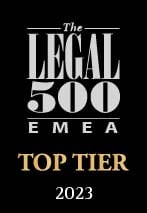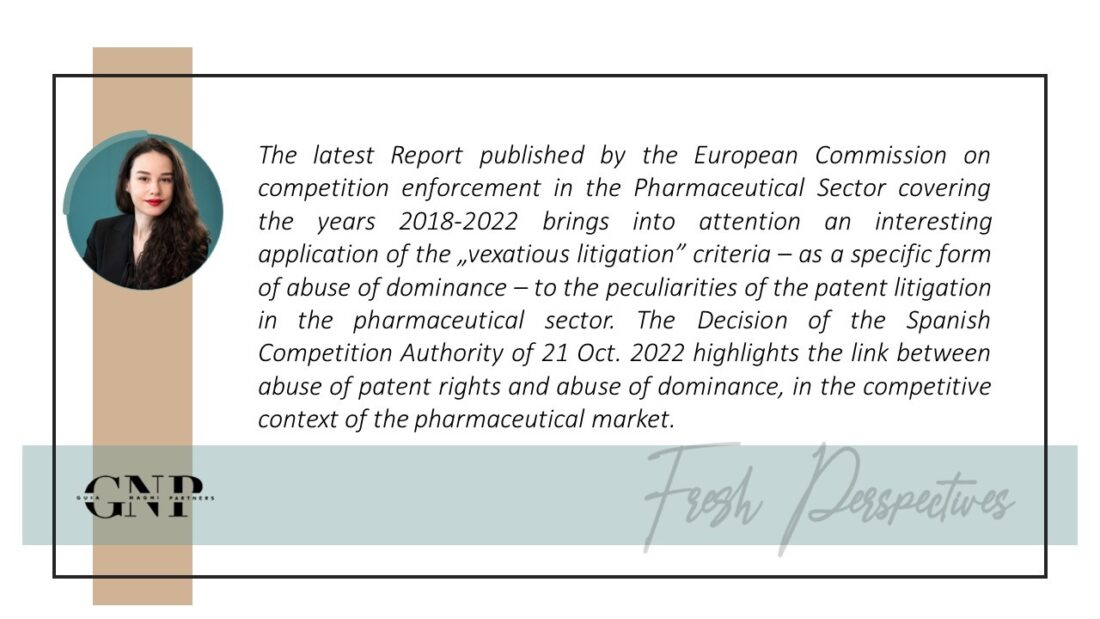Alexandra Stoicescu – Tales from the EC’s Latest Pharma Report: Where Patent Rights End and Abuse of Dominance Begins
On 26 January 2024, the European Commission (the „EC”) published a comprehensive report (the „Report”) aimed to outline the recent competition enforcement in the pharmaceutical sector carried out by the EC and the national competition authorities (the „NCAs”) from 2018 to 2022. This Report highlights the enforcement of both antitrust and merger control rules, complementing the findings of the previous report published on 28 January 2019, which covered the years 2009-2017.
Pursuant to the data published in the Report, half of the decisions that raised competition concerns were cases of abuse of dominant position. Since access to affordable medicines is, along with increase of drive of innovation, a key objective for the European competition authorities in this sector, cases in which certain strategies for delaying the entry of generics on the market have been ascertained and sanctioned were consistently emphasized by the Report. Such strategies are adopted by the manufacturers of innovative medicines specifically to delay the effects of a potential entry on the market of cheaper generic medicines (i.e. the substantial price decrease of their own innovative medicines).
Among others, the conduct of „vexatious litigation”, a rather atypical form of abuse of dominance is presented and discussed as an illegitimate practice meant to artificially extend the commercial life of the medicines protected by patents, in the light of recent investigations in the pharmaceutical sector.
The unreasonable exercise of legal actions may constitute an abuse of dominance
Access to Court is a fundamental right and a general principle of law, recognized both at national level of Member States and at EU level, being also enshrined in Articles 6 and 13 of the European Convention for the Protection of Human Rights and Fundamental Freedoms of 4 November 1950. Any application of the competition rules in relation to the exercise of procedural rights should be carried out with particular care so as not to undermine this fundamental right.
As stated in case-law adopted by the Court of Justice of the European Union („CJEU”) in ITT Promedia NV case[1], bringing legal proceedings could represent an abuse of a dominant position within the meaning of Article 102 of the Treaty on the Functioning of the European Union („TFEU”) only in exceptional circumstances, when the following criteria established by EC and confirmed by CJEU are met:
1st criterion: the action cannot reasonably be considered as an attempt to establish the rights of the undertaking concerned and would therefore serve only to “harass” the opposite party;
2nd criterion: the action is conceived in the framework of a plan whose goal is to eliminate competition (the intent test).
The potential „vexatious” nature of the pharmaceutical patent litigations
On October 2022[2], the Spanish NCA sanctioned a pharmaceutical company with a EUR 38,93 million fine for abusing its dominant position when bringing unjustified legal action against its competitor, a company who had developed an alternative medicinal product, under the guise of safeguarding its patent rights.
In particular, the pharmaceutical company in question requested two types of procedural remedies specific to patent law: (i) fact-finding proceedings (action by which the patent owner could obtain access to important documents and information that are not in its reach) and (ii) ex-parte interim injunction (request for interim measures, without hearing the other party), in order to stop the manufacture and sale of the competitor’s product in Spain.
The company’s actions were considered to be a part of a strategy aimed at extending the duration of the protection conferred by the patent, in order to block or hinder the entry into the market of the new product developed by a competitor. To reach this conclusion, the Spanish NCA analyzed the criteria mentioned in the ITT Promedia NV case, establishing the following:
- The first criterion is met, since the company, among others: (i) in the fact-finding proceedings, falsely claimed that the opposing party refused to offer the requested information, (ii) in the request for interim measures, unequivocally asserted the existence of the infringement of its patent without waiting for the result of the expert report previously ordered, (ii) allowed the main process to lapse, a fact that demonstrated the pure instrumental nature of the legal action.
- The second criterion is met, since the factual elements proved the pursuit of an anti-competitive strategy (i.e. lack of coherence in statements, ignoring successive offers by the other party to provide the necessary information for ruling out patent infringement, all of that combined with the fact that the company seemed to be aware of the potential entry of the generics into the market and of the existence of a competing product long before initiating the legal action).
The presented case highlights the limits of procedural patent rights in the competitive context of the pharmaceutical market. Given the particular focus on the importance of ensuring access to cheap medicines, also highlighted by the Report’s findings, the dominant pharmaceutical companies should be aware of the risks related to the imprudent use of the procedural remedies inherent to patent law.
[1] Case T-111/96, ITT Promedia NV v Commission of the European Communities.
[2] CNMC Decision of 21 October 2022, S/0026/19





No Comments